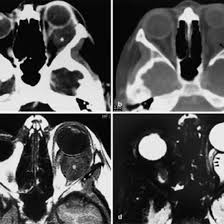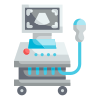Fill out form to enquire now
CECT Orbit Coronal
Medintu has collaborated with the best pathology laboratories that are NABL and NABH certified and follow ISO safety guidelines to provide the best CECT Orbit Coronal at an affordable price for needy individuals. A CECT Orbit Coronal is a specific orbital scan. The orbit is the area surrounding and encompassing the eye socket (orbits). This scan utilizes high resolution images that incorporate the most advanced CT scanning technologies in conjunction with a contrast agent in order to image bones, muscles, nerves, and soft tissues within the orbit. This diagnostic tool is very useful in detecting and assessing several orbital conditions, including fractures, tumors, infections, and inflammatory diseases affecting the eyes and their structures.
A coronal view in CECT allows clear and cross-sectional perspectives of the orbital anatomy, which can easily help visualize complex conditions and treat them appropriately. The CECT Orbit Coronal is normally recommended by doctors when the symptoms indicate orbital trauma, sinus-related problems, or disorders in eye movement, or when the patient presents with some unexplained pain, swelling, or visual disturbances. To schedule an appointment for CECT Orbit Coronal, simply contact Medintu or call our customer care at +919100907036 or +919100907622 for more details and queries.
Indications for CECT Orbit Coronal
A CECT Orbit Coronal is an important diagnostic tool for the evaluation of a wide range of orbital region and surrounding structures’ diseases. It is usually performed when there is a necessity for detailed imaging of both the bones and soft tissues of the orbit. The following are the common indications to perform a CECT Orbit Coronal:
- Orbital Trauma and Fractures
Orbital bones Fractures: CECT Orbit Coronal is specially useful in detecting trauma to fractures involving the orbital bones like orbit blowout fracture and so.
Complex fractures: This study provides high-resolution images regarding the extent of fracture along with the involvement of structures or tissues near to that area, thus aiding the treatment and surgical plan accordingly.
- Orbital Tumors
Orbital tumors: CECT studies outline benign and malignant tumors orbit, such as retinoblastomas, meningiomas, optic nerve gliomas, and lacrimal gland tumors.
Localization of tumor and staging: Such information is essential for therapy planning, such as the size, location, and extent of the tumor- for example, surgery and radiotherapy.
- Orbital Infections and Inflammatory Conditions
Orbital cellulitis: CECT Orbit Coronal is most often applied for the diagnosis of orbital infection like orbital cellulitis which is the infection involving soft tissues around the eyes typically being a bacterial infection
Formation of abscess: This examination is useful in detection for an abscess of orbital region or the other closely related sinuses region.
Intra-orbital abscess or sinusitis-related orbital infection: For those conditions that involve the sinuses or the soft tissues of the orbit, a CECT scan can visualize the spread of infection and assess the need for surgical drainage.
- Orbital Inflammatory Diseases
Graves’ orbitopathy (thyroid eye disease): CECT is useful for assessing the muscle enlargement and orbital fat changes in thyroid-related eye diseases, such as Graves’ disease.
Orbital Inflammation: It helps in detecting inflammatory conditions, such as sarcoidosis or pseudotumor that cause inflammation or changes in orbital tissues.
- Orbital Masses and Cysts
Orbital Cysts: CECT will help diagnose orbital cysts, either lacrimal gland cysts or dermoid cysts. Hence, with this technique it is easy to note about the size, location of the cyst, and influence on other structures in that part.
Lymphoma: It can also help diagnose orbital lymphoma, a form of cancer that involves the lymphatic tissues surrounding the eye.
How Does a CECT Orbit Coronal Work?
A CECT Orbit Coronal is a contrast-enhanced computed tomography scan where advanced CT imaging combines the contrast agent to create high-quality images of the orbital area around the eyes. With both the orbital bones as well as the soft tissue elements, such as muscles, nerves, and blood vessels within the eye sockets viewed in detail, this can be a very effective process in diagnosing a myriad of conditions affecting the orbit. Here’s how a CECT Orbit Coronal works:
- CT Imaging Technology
It is an X-ray-based technique. The CT scanner takes a series of cross-sectional images, or slices, of the body using X-rays. These images are taken from multiple angles to provide a detailed 3D view of the internal structures.
Data processing: It collects data from these X-ray beams as they pass through the body, and a computer works on this data to create a series of detailed 2D images. These images represent the internal structures in thin slices, which can be reconstructed into a 3D model for detailed visualization.
- Use of Contrast Agent
Contrast injection: A contrast agent (usually iodine-based) is injected into the patient’s vein through an intravenous (IV) line to enhance the images. The contrast agent allows soft tissues, such as muscles, nerves, blood vessels, and tumors, which are otherwise not clearly visible from surrounding structures in a standard CT scan, to be better highlighted.
Imaging has enhanced visibility: The contrast agent temporarily circulates in the bloodstream, increasing the contrast between different tissues, hence easy to visualize abnormal or complex structures, such as orbital tumors, inflammatory areas, or muscle enlargement.
- Coronal Plane Imaging
Coronal view-This means the plane in which images are taken. Essentially, this means that the anterior and posterior parts of the human body would be divided to have the coronal view of the pictures taken by slicing the entire body from front to the back, in a cross-section almost like one. For instance, by having the coronal view for the orbit; this way, the images captured show the bones in conjunction with the soft tissue and have a clear understanding of its structure and abnormalities.
In terms of detailed analysis of orbital structures, this plane is very important when assessing the orbital bones and also evaluating the extraocular muscles besides the sinus regions around the eyes. Contrast helps the details of ocular nerves, blood vessels, or abnormal masses/tumors present.
- Reconstruction of Images
3D imaging: Once the images are taken, the computer reconstructs them into detailed, 3D images that provide a comprehensive view of the orbital region. This allows for precise localization of fractures, tumors, infections, or abnormalities.
Pathology Assessment: Increased contrast allows the radiologist to differentiate between normal anatomical structures and abnormal findings. This aids in identifying diseases, for example, orbital fractures, tumors, or inflammatory conditions that affect soft tissues and bone.
- Limited Patient Movement and Positioning
Patient positioning: The patient has to be positioned correctly inside the CT scanner for an accurate scan. For a CECT Orbit Coronal, the patient will lie down with the head placed in the scanner in such a way that it positions the eyes well for imaging. They could be requested to remain immobile during the scanning to avoid blur on the images.
Comfort and safety: The process is non-invasive and, on average, will only ask patients to stay stationary for a short time during which the images are taken. Patients are monitored by the medical team, although discomfort associated with the procedure may arise from factors such as contrast injection.
Benefits of CECT Orbit Coronal
A CECT Orbit Coronal provides a lot of benefits for the diagnosis and evaluation of diseases involving the orbital region or structures around the orbit. These are the advantages in this imaging technique:
- Highly Detailed Imaging
Detailed visualization: CECT Orbit Coronal provides resolution images that can capture well the fine details of both bone and soft tissues, comprising muscles, nerves, vessels, and fat. At this level of detail only can a wide range of conditions be diagnosed with exactness.
Good differentiation of pathology: The contrast agent affords better contrast for the discrimination between normal tissues and pathologic lesions, including tumors, cysts, and inflammation.
- Good Visualization of Orbital Fractures
Detailed bone analysis: CECT scans are highly effective in identifying fractures of the orbital bones, such as a blowout fracture, that are common in trauma to the eye area. Contrast agent helps highlight fractures both in the bony structures and surrounding tissues.
Comprehensive review: This scan provides an excellent overview of the number of fractures and can help point to orbital involvement in facial trauma cases and thus helps in surgical planning and management.
- Evaluation of Orbital Tumors and Masses
Tumor detection: CECT Orbit Coronal is very useful in diagnosing benign and malignant tumors in the orbit. The resolution of this scan is good enough to show retinoblastomas, meningiomas, lacrimal gland tumors, and optic nerve gliomas.
Tumor localization and staging: The detailed images will help assess the size, location, and extent of the tumor, which are vital for treatment planning (e.g., surgery, radiation therapy, or chemotherapy).
- Assessment of Orbital Infections
Orbital cellulitis: CECT Orbit Coronal is very sensitive for the diagnosis of orbital infections, like orbital cellulitis, an infection of the tissues surrounding the eyes that may be a life-threatening condition if left untreated.
Abscess detection: The scan may show intra-orbital abscesses, sinus infection, or infections that extend from adjacent structures like sinuses or nasal cavity, thereby guiding appropriate interventions.
- Assessment of Inflammatory Conditions
Orbital inflammation: In conditions such as thyroid eye disease, also known as Graves’ orbitopathy, or pseudotumor, there may be swelling and enlargement of the muscles and tissues surrounding the eyes. CECT scans will help in assessing these conditions with good visualization of the enlarged muscles and other inflammatory changes.
Inflammatory conditions around the orbit: The scan may help diagnose sarcoidosis or other diseases of inflammation that affect soft tissues at the orbital region.
- Test Type: CECT Orbit Coronal
- Preparation:
- Wear a loose-fitting cloth
- You may need to fast for 4–6 hours before the scan
- Carry Your ID Proof
- Prescription is mandatory for patients with a doctor’s sign, stamp, with DMC/HMC number; as per PC-PNDT Act
- Reports Time: With in 4-6 hours
- Test Price: Rs.5000
How to book an appointment for a CECT Orbit Coronal?
To schedule an appointment for CECT Orbit Coronal, simply contact Medintu or call our customer care at +919100907036 or +919100907622 for more details and queries.
What is CECT Orbit Coronal?
It is a specially designed CT scan of the orbital area (eye socket) involving a contrast that helps outline both bone as well as soft tissues. From the coronal view, doctors have the ability to diagnose most conditions affecting the eyes as well as the surrounding bones, muscles, and nerves.
What are my reasons for requiring the CECT Orbit Coronal?
It is applied to assess the following conditions:
- Orbital fractures due to trauma or injury
- Eye infections or orbital cellulitis
- Tumors or cysts in the orbit
- Sinus-related issues that affect the orbital region
- Abnormal eye movement resulting from muscle or nerve conditions
- Congenital anomalies like cysts or facial abnormalities
Is CECT Orbit Coronal painful?
No, the procedure is usually painless. The most discomfort you might feel is when the contrast agent is injected, which may cause a brief warm sensation or a metallic taste in your mouth. The procedure itself is non-invasive and involves no needles or cutting.
How long does the CECT Orbit Coronal procedure take?
The scan usually takes between 15 to 30 minutes. The process is not time-consuming, and you are able to resume your regular activities right away.
Do I need to prepare for the CECT Orbit Coronal scan?
Preparation is very minimal
- You will likely be told to fast a few hours before the procedure, depending on if contrast is used
- You should also remove metal objects like jewelry, glasses, and dentures.
- Inform your doctor about any allergies (especially to iodine or contrast materials), and any pregnancy or breastfeeding status.
What happens during the procedure?
You will lie down on a CT scanning table, and the technician will position you in such a way that your eyes are properly aligned for the scan. Then, you will be injected with a contrast agent through an intravenous line. The scanner will take a series of images from different angles, and the whole process will be done in a matter of minutes.
Are there any risks or side effects associated with the scan?
The risks are minimal, but:
- Radiation exposure is involved, though it is low and controlled.
- Some people may experience a mild allergic reaction to the contrast material, but this is rare. It may cause a warm sensation, nausea, or a metallic taste in the mouth, which usually disappears quickly.
- If you are pregnant, your doctor will determine if the procedure can be done because of radiation.
How long will it take to obtain the results?
The result usually takes a few hours up to a couple of days. The radiologist interprets the images and delivers his findings to your doctor, who talks it over with you.
Why Choose Medintu for CECT Orbit Coronal?
Medintu is an online medical consultant, which offers home services not only in your city but also in all major cities of India, such as Hyderabad, Chennai, Mumbai, Kolkata and others. This makes it easy for us to work with diagnostic centers that boast of having the most accurate equipment. The customer service for booking the appointment of the services is available 24/7 and Medintu also comes with instructions. Medintu has not only the best diagnostic centres, but it offers them at very cheaper prices. If you have been tested, you can promptly schedule an appointment with a health care service through our list of skilled physicians. For appointment for CECT Orbit Coronal, you can chat with us through Medintu or call our customer care at 919100907036 or 919100907622 for more information or inquiries.





